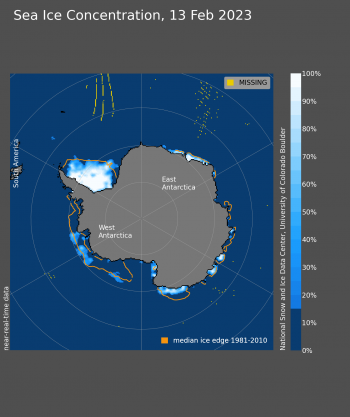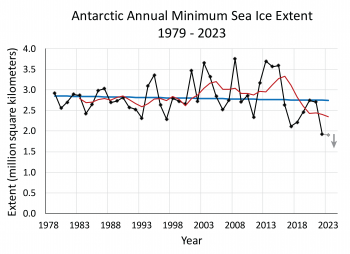Antarctic sea ice extent appears to have broken the record low set last year. With a couple more weeks likely left in the melt season, the extent is expected to drop further before reaching its annual minimum. Much of the Antarctic coast is ice free, exposing the ice shelves that fringe the ice sheet to wave action and warmer conditions.

Extent has tracked well below last year’s melt season levels since mid-December. As noted in our previous post, a positive Southern Annular Mode has led to stronger-than-average westerly winds. Along with a strong Amundsen Sea Low, the weather conditions have brought warm air to the region on both sides of the Antarctic Peninsula. This has largely cleared out the ice cover in the Amundsen and Bellingshausen Seas, and reduced the sea ice extent in the northwestern Weddell Sea. Sea ice is patchy and nearly absent over a long stretch of the Pacific-facing coastline of Antarctica. Earlier studies have linked low sea ice cover with wave-induced stresses on the floating ice shelves that hem the continent, leading to break up of weaker areas.

Figure 2. This graph shows Antarctic annual sea ice minimum extent, depicted as black diamonds, from 1979 to 2023, based on a 5-day running average of daily extent. The grey diamond data point depicts the 2023 minimum, which is still preliminary, with further loss expected. The linear trend line is in blue with a 0.9 percent per decade downward trend, which is not statistically significant. A five-year running average is shown in red. As the Antarctic melt season is still in progress, depicted as a grey downward arrow, the linear trend and running average will change slightly.
The Southern Polar Sea Ice seems to have been fairly stable over the last few years, providing a counterbalance to the rapid warming occurring in the Arctic Basin. Could this mean that global warming has finally arrived in the Antarctic?
Source: NSIDC.org